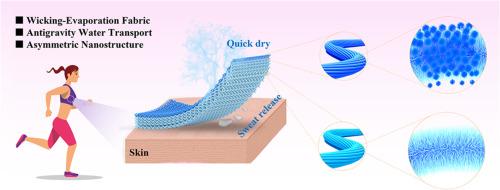Bioinspired Composite Fabrics with Nanoneedle Structures for High Wicking-Evaporation performance
IF 8.3
2区 材料科学
Q1 MATERIALS SCIENCE, MULTIDISCIPLINARY
引用次数: 0
Abstract
Achieving ultrafast antigravity water transport and evaporation in high-performance moisture-wicking fabrics remains a significant challenge in textile engineering. In this study, we introduce two novel asymmetric composite fabrics, NN-TS/PET/BS and NS-TS/PET/BS, developed through a straightforward one-step method. These fabrics incorporate different hydrophilic nanostructures—nanoneedles (NN) and nanosheets (NS) of cobalt carbonate—to enhance wicking-evaporation capabilities. The NN-TS/PET/BS fabric exhibited superior unidirectional water transport and evaporation performance, achieving a one-way transport value (R) of up to 330 %, an outstanding overall moisture management capacity (OMMC) of 0.87, and a rapid water evaporation rate of 0.5 g h⁻¹, which is 2 and 2.3 times higher than that of NS-TS/PET/BS and Coolmax, respectively. Detailed analyses revealed that the curvature gradients in the nanoneedles significantly enhanced the wetting and evaporation stages, facilitating efficient antigravity water transport. Wear studies confirmed that the NN-TS/PET/BS fabric could swiftly remove sweat from the skin surface, enhancing comfort and performance. These findings offer new perspectives for developing high-performance unidirectional water transport fabrics with broad application potential, including smart textiles, fog harvesting, and wound dressings.

具有纳米针刺结构的生物启发复合织物可实现高吸水-蒸发性能
在高性能吸湿排汗织物中实现超快反重力水传输和蒸发仍然是纺织工程中的一项重大挑战。在本研究中,我们介绍了两种新型不对称复合织物:NN-TS/PET/BS 和 NS-TS/PET/BS,它们都是通过简单的一步法开发出来的。这些织物采用了不同的亲水性纳米结构--纳米针(NN)和碳酸钴纳米片(NS),以增强吸湿蒸发能力。NN-TS/PET/BS织物具有优异的单向水分传输和蒸发性能,单向传输值(R)高达330%,整体水分管理能力(OMMC)达到0.87,水分快速蒸发率为0.5 g h-¹,分别是NS-TS/PET/BS和Coolmax的2倍和2.3倍。详细分析显示,纳米针中的曲率梯度显著增强了润湿和蒸发阶段,促进了高效的反重力水传输。穿着研究证实,NN-TS/PET/BS 织物能迅速清除皮肤表面的汗液,从而提高舒适度和性能。这些发现为开发具有广泛应用潜力的高性能单向水传输织物提供了新的视角,包括智能纺织品、雾气收集和伤口敷料。
本文章由计算机程序翻译,如有差异,请以英文原文为准。
求助全文
约1分钟内获得全文
求助全文
来源期刊

ACS Applied Materials & Interfaces
工程技术-材料科学:综合
CiteScore
16.00
自引率
6.30%
发文量
4978
审稿时长
1.8 months
期刊介绍:
ACS Applied Materials & Interfaces is a leading interdisciplinary journal that brings together chemists, engineers, physicists, and biologists to explore the development and utilization of newly-discovered materials and interfacial processes for specific applications. Our journal has experienced remarkable growth since its establishment in 2009, both in terms of the number of articles published and the impact of the research showcased. We are proud to foster a truly global community, with the majority of published articles originating from outside the United States, reflecting the rapid growth of applied research worldwide.
 求助内容:
求助内容: 应助结果提醒方式:
应助结果提醒方式:


